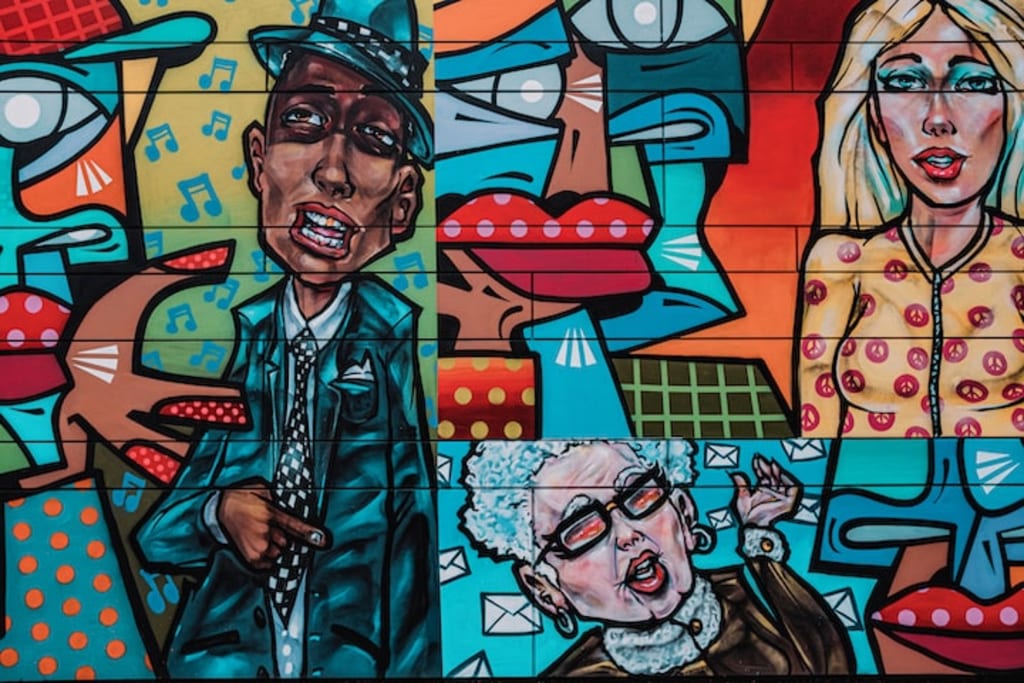
A good case can be made that the political cartoon, by its very nature, is a form of propaganda. This is not necessarily a bad thing, though propaganda as generally understood has negative connotations. René Welleck in his Theory of Literature argues that
The term “propaganda” is loose and needs scrutiny. In popular speech, it is applied to doctrines viewed as pernicious and spread by men whom we distrust. The word implies calculation, intention, and is usually applied to specific, rather restrictive doctrines or programmes. (Zazlove 1997)
Jerry Zazlove asks the question, “Can there be both ‘positive’ propaganda and ‘negative’ propaganda?” He cites Harold Laswell to the effect that propaganda can be viewed neutrally: Propaganda “in the broadest sense… (is) the technique of influencing human action by the manipulation of representations” in different media. He argues that even such a seemingly benign philosophy as humanism indulges in propaganda.
Humanist essays contain elements like name-calling, ridicule and degrading invective, project judgments about the motivations of enemies, blasphemy, and caustic sarcasm formed in the crucible of the dissenting traditions.
Jonathan Swift was a master of this technique, using humor and wit to skewer some of the prevailing ideas of his age. Consider his Gulliver’s Travels or A Modest Proposal. The great Canadian humorist Stephen Leacock lampooned the upper classes in Arcadian Adventures With the Idle Rich. It’s interesting to note that these two masters were humorists. So too is the political cartoonist. Humor is his stock in trade but his target is inevitably the cultural mores of the time or throwing a light on some of the absurdities of political figures of the day. So let us examine three separate political cartoons in some detail.
War Propaganda
The political cartoon is most often seen as propaganda during wartime or during similar periods of insurrection and violence. These events generate heated emotions. As Mark Bryant points out in History Today:
Not all cartoons are funny. They can also be witty, satirical, grotesque, obscene and vicious without being comic. And in the case of political cartoons in wartime they are often deliberately designed to inflame public opinion against an enemy - a powerful weapon in the armory of propaganda departments on both sides of a conflict. (60)
During World War I, the Netherlands was one of only nine countries in the world that managed to remain neutral during the war. The Scandinavian states of Denmark, Norway and Sweden, as well as Switzerland, were also neutral. Despite his government’s neutrality, Dutch cartoonist Louis Raemaeker made no secret of where his sympathies lay. Bryant notes that the Dutch cartoonist “was so provocative” with his cartoons portraying the Central Powers during World War I
that Kaiser Wilhelm offered to pay 12,000 Dutch guilders to whoever captured him (dead or alive). He was even prosecuted by his own government for jeopardizing Holland's neutrality and British prime minister Lloyd George was so impressed by his drawings that he sent him to the US to convince the Americans to enter the war. (60)
Below is his depiction of the murder of nurse Edith Cavell.
Along with the caption is this description: “Note that the pigs around her corpse not only wear pickelhaube helmets but the one in the foreground even has an Iron Cross pinned to its tail.” Bryant quotes Raemaeker on his work:
It has been my one aim since the breaking out of the war to accentuate the brutish character of the Germans. The brute is in them and I have tried to bring it out, but try as hard as I can I cannot depict it strong enough. I cannot make my pictures as brutish as the actual truth. (60)
Acquitted of the charges layed on him by the Dutch government, Raemaekers emigrated to England to circumvent the Kaiser’s threat of assassination and in 1917 to the United States. His cartoons were widely published across Europe and Sir Harry Perry Robinson, the war correspondent for The Times, “held that he was one of the six great men - including statesmen and military commanders - whose effort and influence were most decisive during the First World War.” (61)
In America he worked for the Hearst papers and President Theodore Roosevelt himself wrote the forward to a collection of his cartoons published as a book:
The cartoons of Louis Raemaekers constitute the most powerful of the honorable contributions made by neutrals to the cause of civilization in the World War… He has left a record which will last for many centuries... He draws evil with the rugged strength of Hogarth and in the same spirit of vehement protest and anger. He draws sorrow and suffering with all Hogarth's depth of sympathy. His pictures should be studied everywhere. (61)
From the Great War let’s move to more modern times.
Arabic Reaction to the Charlie Hebdo Massacre
In the book he co-authored with Peter Desbarats on the history of Canadian political cartooning, Terry Mosher, the cartoonist known as Aislin, notes that
Most cartoonists working today are street-wise in that they have experienced the frustrations of the average individual in dealing with the suspicious factors that exert control over our lives. This experience hones the pen far better than a degree in political science. (5)
Mosher continues, noting that during the nineteenth century when French caricaturist Honoré Daumier was skewering the potentates of his day,
the targets may have been more blatant - kings, cardinals and judges who embodied the differences between the haves and the have-nots, Today the foe is far more nebulous, weaving its way through government, bureaucracy, and big business. But the target remains the same: Privilege. (5)
In his book, The Power and the People: Paths of Resistance in the Middle East, Charles Tripp echoes Mosher’s view, noting that visual art can “develop a new vernacular, an idiom that can give voice to the voiceless, representing and even giving reality to forms of collective experience and identity” (260).
On January 7, 2015, armed Islamist terrorists stormed the office of the Parisian satirical magazine Charlie Hebdo, killing twelve and wounding eleven more. The attack was revenge for cartoons the magazine published depicting the prophet Mohammed over the years. The magazine lampooned all religions but only the radical fringe of Islam took umbrage. In an article in Arab Studies Quarterly, Sadam Issa looks at the reaction to the Charlie Hebdo attack in Arab circles.
The article is remarkable because it is generally believed in the West that Muslims in general supported this murderous attack, a view that Issa refutes in his essay. The abstract looks at eleven cartoons from the Arabic press in the wake of the attack, none supporting it. The targets of the cartoons vary, but they all speak to power; as Mosher and Tripp pointed out, they give voices to the voiceless. The Arab Spring of the early 2010s was, in fact, an uprising of these voiceless people. Issa argues that “Studying how Arabic political cartoons, as a form of popular culture, depict political events such as the Charlie Hebdo incident provides a political and cultural alternative for interpreting these events.” (563)
Issa discusses the cartoons in considerable depth and points out their varied targets. These include:
criticism of the Arabic leadership, criticism of the international community, Israel as the only beneficiary actor from the Charlie Hebdo incident, and criticism of shooting the cartoonists, and criticism of the mocking cartoons. (568)
This short overview will look at two of these cartoons. The first is by Ahmed Al Rahma and was published by Al-Jazeera Online. Issa explains the cartoon, which is in Arabic.
Al-Jazeera Arabic online ran this cartoon by Ahmad Rahma showing an Arabic soldier with a big mustache sitting on a cage, crying and carrying an “anā shālrī” “I am Charlie” placard heading toward, which is indicated by the instructional sign in front of him that reads “pāris” “Paris.” The cartoon also shows a group of journalists and photographers imprisoned in a cage holding a sign that reads “huriyyah” “Freedom.” A dead body lies outside the cage, who is presumably a journalist as well. (569)
Issa continues with an interpretation of the cartoon. He refers to the Paris Solidarity Rally following the massacre in which many world leaders, including Arab leaders, expressed solidarity with the people of Paris and supported freedom of expression.
Here, the Arabic soldier symbolizes the Arabic presidents who participated in the Paris Solidarity Rally. The… cartoon communicates the hypocrisy and double standards of the Arabic leadership. The hypocrisy and double standard occur when the Arabic president laments the Charlie Hebdo incident and shows solidarity with its victims while neglecting the Arabic journalists who he presumably imprisoned. The cartoon visually depicts this ignorance by having the Arabic president sit on the prison and turn his back to the journalists. The jail is depicted as if it is an animal cage. The ceiling of the cage is as low as the ceiling of freedom of expression in the Arab world. (569)
Issa goes on to show several cartoons that indicate the double standards of both Arab leaders and the international community commiserating with the victims of the Paris attack while turning a blind eye to the Palestinian and Syrian refugee crises. He shows a cartoon that compares the total non-response of Western states to the assassination of Arab cartoonist Naji Al-Ali in 1987. He shows a couple of cartoons pointing out that the only beneficiary of these attacks was Israel who used them to advantage to portray the Arab world as extremist and thus fostering Islamophobia. And he shows a couple of cartoons condemning terrorism and supporting freedom of speech. One of them is shown below.
Issa explains the cartoon thus:
In a personal communication with Emad Hajjaj, who drew this cartoon, Hajjaj expressed his condemnation of the attack on the cartoonists. The caption of the cartoon clearly portrays his condemnation, which reads “fī idanat al-‘amal al-irhābī al-lathī istahdafa sahīfat (shālrī ibdū)” “in condemning the terrorist attack that targeted Charlie Hebdo magazine.” The cartoon consists of a speech balloon that reads “freedom of speech” written both in Arabic and in English. Then, the cartoon portrays a black sword written on it “al-Irhāb” “Terror” in Arabic and in English. Out of the speech bubble, a long line shaped as a sword cuts the black sword. The cartoon uses two metaphors: “Freedom of speech is a sword” and “terror is a sword.” The cartoon shows that “the sword of freedom of speech” cuts “the sword of terror,” indicating that “freedom of speech” will win over “terrorism.” (578-579)
Political cartoons are, sadly, often unappreciated for the serious journalism that they are. Mark Hampton writes in Journalism Studies that
Journalism scholars, though, have not been quick to appreciate the political cartoon as a journalistic genre; to take one prominent indicator, the authoritative Routledge Companion to News and Journalism does not include an article on cartoons (Allan 2010). This scholarly neglect has its counterpart in journalism practice, what contemporary political cartoonist Martin Rowson (2010) calls a ‘‘systemic failure within newspapers to appreciate that cartoons are serious journalism’’. (681)
But, as Mosher and Tripp have noted, they serve the citizen as a powerful tool to expose inequities and hypocrisies within the establishment. They are often sharp-witted with a cutting bite to them. As the Hajjaj cartoon suggests, freedom of speech will triumph over terrorism. And it will triumph over government efforts at suppression. As Edward Bulwer-Lytton famously put it, “The pen is mightier than the sword!”






Comments
There are no comments for this story
Be the first to respond and start the conversation.